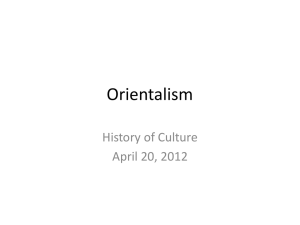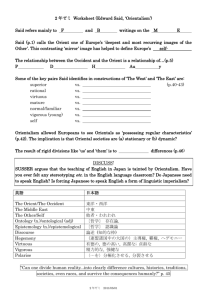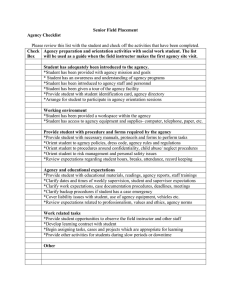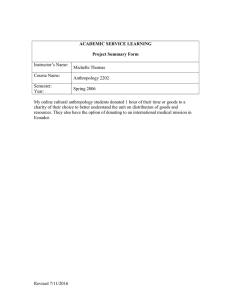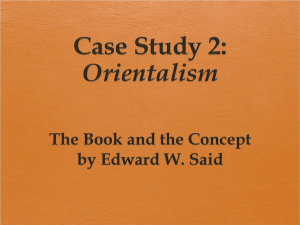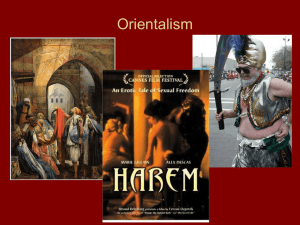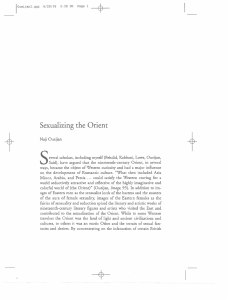Anthropology and Postcolonialism The Influence of Edward Said
advertisement
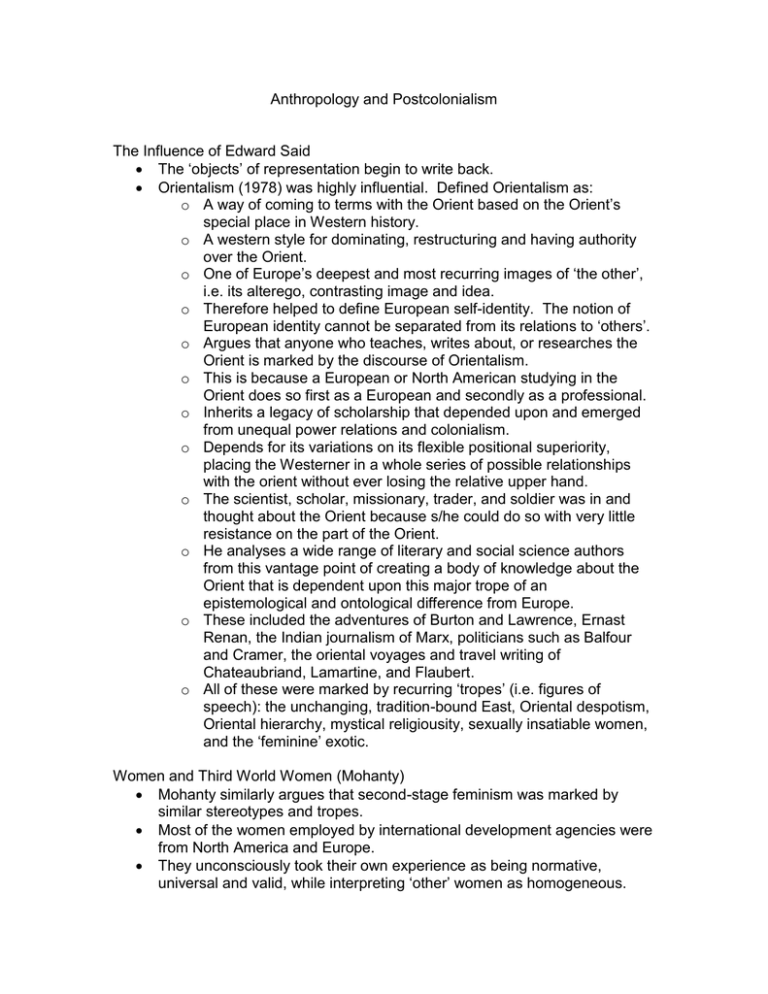
Anthropology and Postcolonialism The Influence of Edward Said The ‘objects’ of representation begin to write back. Orientalism (1978) was highly influential. Defined Orientalism as: o A way of coming to terms with the Orient based on the Orient’s special place in Western history. o A western style for dominating, restructuring and having authority over the Orient. o One of Europe’s deepest and most recurring images of ‘the other’, i.e. its alterego, contrasting image and idea. o Therefore helped to define European self-identity. The notion of European identity cannot be separated from its relations to ‘others’. o Argues that anyone who teaches, writes about, or researches the Orient is marked by the discourse of Orientalism. o This is because a European or North American studying in the Orient does so first as a European and secondly as a professional. o Inherits a legacy of scholarship that depended upon and emerged from unequal power relations and colonialism. o Depends for its variations on its flexible positional superiority, placing the Westerner in a whole series of possible relationships with the orient without ever losing the relative upper hand. o The scientist, scholar, missionary, trader, and soldier was in and thought about the Orient because s/he could do so with very little resistance on the part of the Orient. o He analyses a wide range of literary and social science authors from this vantage point of creating a body of knowledge about the Orient that is dependent upon this major trope of an epistemological and ontological difference from Europe. o These included the adventures of Burton and Lawrence, Ernast Renan, the Indian journalism of Marx, politicians such as Balfour and Cramer, the oriental voyages and travel writing of Chateaubriand, Lamartine, and Flaubert. o All of these were marked by recurring ‘tropes’ (i.e. figures of speech): the unchanging, tradition-bound East, Oriental despotism, Oriental hierarchy, mystical religiousity, sexually insatiable women, and the ‘feminine’ exotic. Women and Third World Women (Mohanty) Mohanty similarly argues that second-stage feminism was marked by similar stereotypes and tropes. Most of the women employed by international development agencies were from North America and Europe. They unconsciously took their own experience as being normative, universal and valid, while interpreting ‘other’ women as homogeneous. Third World women became an image that was synonymous with tradition, lack of literacy, education, training, jobs, and extreme oppression. Assumption is of women as an already constituted, coherent group with identical interests and desires. Proof of universality and cross-cultural validity is supplied by constituting an ‘average’ Third World woman who leads a truncated life based on her gender and being third world. The homogeneity of women is produced through the analytic of oppression, thus conflating women as an analytic category with the specific historical and cultural experiences of particular women. o E.g. PErdita Huston: studies the effect of the development process on the family unit and women in Egypt, Kenya, Sudan, Tunisia, Sri Lanka and Mexico. Problems of women, both rural and urban in these diverse countries centre around education and training work and wages, access to health services, political participation and legal rights. The solution therefore is simple: implement gender-sensitive development policies. Assumes that all women have similar needs and goals. Also assumes that they have needs and problems, but very little agency. Yet women are constituted as subjects through complex interactions between class, culture, religion and other institutions, values and ideologies. Problem is first of homogenization and secondly of the normative assumption of the ‘outsider’s’ superiority. o E.g. Fran Hosken an female circumcision in Eastern Africa: Interprets it as being a ritual to ‘mutilate the sexual pleasure and satisfaction of women.’ Part of a universal political practice to assure female dependence and subservience by any and all means. Circumscribes women as archetypical victims and freezes them into ‘objects who defend themselves and men into subjects who perpetuate violence. Does not think that any ‘emic’ definitions of female circumcision is important, e.g. the female circumcision among the Kikuyu of Kenya is a ritual that provides women with property rights and adult membership in a kin group. Cannot therefore understand the resistance of the Kikuyu to missionary and medical attempts to abolish the ritual. The Effects of Said and Mohanty on Anthropology Postcolonial critique obviously included anthropology, since this is the discipline that has traditionally studied ‘others’. Stimulated a critical excavation of anthropological history and its representations: o South Asia: Arjun Appadurai on hierarchy. Bernard Cohn on caste and censuses. Subaltern studies and representation of the marginalized. Fabian: Time and the ‘Other’. Trouillot: The Savage Slot Argues that anthropology should not only excavate the various internal tropes that have structured our perceptions of ‘others’. It should also examine the relation of anthropology to other disciplines and to its role in western history. The self-definition of Europe was based on three related processes: o Definition of nation states as exemplary of order, as a model that was to spread in the 18th and 19th centuries, the ‘other’ of this was ‘savagery’ (e.g. Locke on Amerindians). o Genealogy of Europe was constructed during the Renaissance that divested Christianity of any ‘Oriental’ origins and influences. o This order was constituted by its alterity, i.e. of ‘utopias.’ o Utopias were romanticized ‘others’ that served as both a counterfoil and a hope for change, e.g. Diderot, Rousseau. o Utopias were the space from within which anthropology emerged. o Historically, travellers’ writings in the utopian vein became ethnographies. How to Move Beyond the Savage Slot? Recognize that there is no ‘other’ but multitudes of others. Discipline whose object has been ‘the other’ may now not have an object. Recognize the dialogic nature of ethnography, and its imperfect goals of cultural translation. Try to overcome the power relations in the academy: o To make anthropology less centred on issues emanating from the western academy. o To recognize that the metanarratives of the European enlightenment are no longer an unconscious vantage point.
